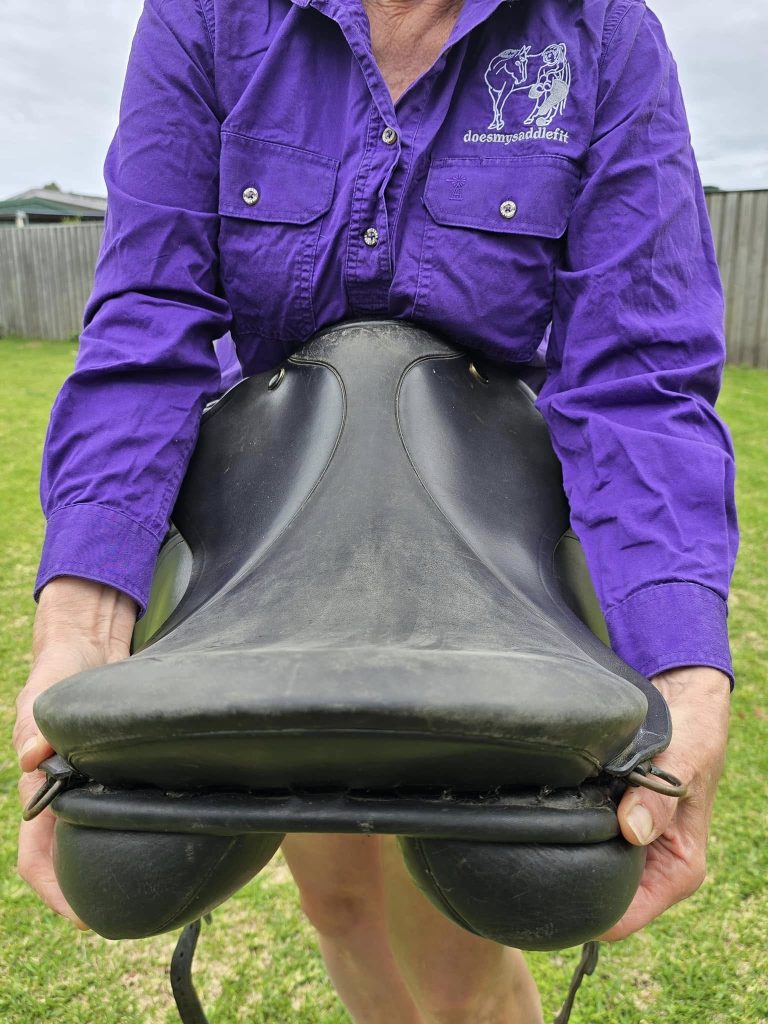When was the last time you gave your Saddle a Health Checkup?
How Healthy is Your Saddle?
As horse lovers, we invest significant time, effort, and resources into our equine partners. From high-quality feed to the best veterinary care, we strive to give them the best possible life. Yet, one critical aspect of equine health is often overlooked—saddle fit. A poorly fitting saddle can cause discomfort, behavioural issues, and even long-term damage. So, how healthy is your saddle?

The Hidden Costs of an Unhealthy Saddle
A saddle that doesn’t fit correctly can lead to stiffness, resistance, and a decline in performance. Many riders spend years training and conditioning their horses, only to struggle with seemingly inexplicable issues. I understand this frustration firsthand. As a competitor, coach, and trainer, I encountered horses that started strong but later found certain tasks difficult. It wasn’t until I explored equine bodywork, biomechanics, hoof balance, nutrition and ultimately saddle fitting that I discovered the root cause—many of these horses were simply in pain.
A poorly fitting saddle isn’t just a minor inconvenience; it can cause muscle atrophy, soreness, and behavioural changes. Your horse might start pinning their ears back, refusing jumps, or exhibiting tension under the saddle. If left unchecked, these discomforts can develop into chronic pain conditions, affecting your horse’s long-term soundness and willingness to work with you.
Why a Saddle Health Check is Essential
Just like routine vet visits and farrier appointments, a saddle health check should be part of your horse’s care routine. A thorough assessment will help ensure your saddle isn’t causing harm and is functioning as intended.
Key areas to examine include:
- Manufacturing Defects – Is your saddle symmetrical? Are there any loose or faulty metal pieces?
- Wear and Tear – Check for unravelling stitching, cracks in leather, uneven panels and signs of excessive use.
- Tree Integrity – A broken tree can be disastrous for both horse and rider. Look for wrinkles in the seat, unusual flexing, or unexplained noises when riding.
If you’re unsure about any of these areas, it’s best to consult a professional saddle fitter or saddler. Remember, even high-end saddles can develop issues over time, so routine checks are a must.
Common Saddle Fit Issues and Their Impact
A saddle that doesn’t fit correctly can manifest in various ways. Here are some common red flags:
- Bridging
If your saddle doesn’t distribute weight evenly along the horse’s back, it can lead to pressure points and muscle atrophy. Horses with a dipped back or high withers are particularly prone to this issue.
- Pinching or Tightness
If your horse flinches or reacts negatively when you saddle up, the tree might be too narrow. This can restrict movement and cause discomfort in the shoulders and along the long back muscles.
- Rocker Effect
A saddle that rocks forward and backward instead of sitting evenly can create friction and soreness, especially in the loin area.
- Girth Placement Issues
A girth that slides too far forward can pull the saddle out of position, leading to discomfort and imbalance.
Take Charge of Your Horse’s Comfort
The good news? You don’t have to be an expert saddle fitter to take the first steps toward a healthier saddle. I’ve developed a Saddle Health Checklist that helps you assess your saddle with confidence. It includes everything from checking for broken trees to evaluating panel balance and leather integrity.
Next Steps: Finding the Correct Fit
If you’ve conducted a basic saddle health check and suspect issues, the next step is identifying whether a saddle truly suits your horse. This involves:
- Understanding your horse’s saddle fit area
- Learning to assess balance and tree width
- Recognising signs of pressure points
- Understanding your and your horse’s saddlefit characteristics
Want to learn more? My Identifying the Horse’s Saddle Fit Area course walks you through the process step by step. Visit https://doesmysaddlefit.info to get started on your journey toward a pain-free partnership with your horse.
Your Horse Deserves the Best
When we choose a saddle, we’re not just selecting tack—we’re investing in our horse’s comfort, performance, and happiness. By committing to regular saddle health checks and seeking professional guidance when needed, you ensure a better riding experience for both you and your horse.
Are you ready to take the next step toward correct saddle fit? Let’s work together to create a pain-free, harmonious partnership between you and your horse.
For more saddle fitting tips and resources, visit https://doesmysaddlefit.info.
